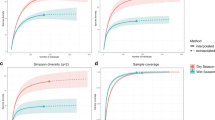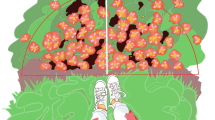Abstract
Interactions between plants and floral visitors have a significant influence on the structure and function of ecosystems. The study of these interactions can be performed through the analysis of ecological networks, allowing an understanding of the complexity of ecosystem functioning. The objective of the present study was to verify whether the characteristics of individuals of Byrsonima intermedia (Malpighiaceae) affects its role in the network of interactions with floral visitors in Brazilian palm swamps (veredas). Veredas with different levels of dryness were studied, including one degraded vereda (advanced stage of drying), one intermediate vereda (low drying), and one preserved vereda (no drying). For sampling, we selected 45 individuals of the Byrsonima intermedia plant, 15 in each area, where they were monitored to observe the behavior of floral visitor insects and to measure the characteristics of the plant individuals. As a result, the networks of all sampled area were significantly modular and specialized, with the preserved vereda showing greater specialization. In this study, we observed that the networks of individuals of Byrsonima intermedia and their floral visitors were mainly composed of non-oil-collecting bees. The results show that the abundance of resources offered by each individual in the network, the size of the flower and the plant height are some factors that can determine its role in the network of interactions in the studied veredas. Finally, it is concluded that individual plant interactions can be affected both by environmental characteristics and by plant morphological attributes.




Similar content being viewed by others
References
Aguiar JC, Melo GAR (2011) Revision and phylogeny of the bee genus Paratetrapedia Moure, with description of a new genus from the Andean Cordillera (Hymenoptera, Apidae, Tapinotaspidini). Zool J Linn Soc 162:351–442. https://doi.org/10.1111/j.1096-3642.2010.00678.x
Alvares CA, Stape JL, Sentelhas PC, Gonçalves JLM, Sparovek G (2014) Koppen’s climate classification map for Brazil. Meteorol Z 22:711–728. https://doi.org/10.1127/0941-2948/2013/0507
Alves-dos-Santos I, Machado IC, Gaglianone MC (2007) História natural das abelhas coletoras de óleo. Oecol Bras 11:544–557. https://doi.org/10.4257/oeco.2007.1104.06
Araújo MS, Guimarães PR Jr, Svanback R, Pinheiro A, Guimarães P (2008) Network analysis reveals contrasting effects of intraspecific competition on individual versus population diets. Ecol Lett 89:1981–1993. https://doi.org/10.1890/07-0630.1
Araújo GM, Barbosa AAA, Arantes AA, Amaral AF (2009) Composição florística De veredas no Município De Uberlândia, MG. Braz J Bot 25:475–493. https://doi.org/10.1590/S0100-84042002012000012
Arroyo-Correa B, Bartomeus I, Jordano P (2021) Individual-based plant-pollinator networks are structured by phenotypic and microsite plant traits. J Ecol 109:2832–2844. https://doi.org/10.1111/1365-2745.13694
Ávila MA, Mota NM, Souza SR, Santos RM, Nunes YRF (2021) Diversity and structure of natural regeneration in swamp forests in Southeastern Brazil. Floram 28:e20190110. https://doi.org/10.1590/2179-8087-FLORAM-2019-0110
Balestra CL, Fachardo ALS, Soares MP, Reys P, Silva FG (2014) Reproductive biology and pollination of two species of Byrsonima Kunth in a Cerrado fragment in Central Brazil. Rev Bioci 20:71–81
Beckett SJ (2016) Improved community detection in weighted bipartite networks. R Soc Open Sci. https://doi.org/10.1098/rsos.140536. 3:140536
Benkman CW (2013) Biotic interaction strength and the intensity of selection. Ecol Lett 16:1054–1060. https://doi.org/10.1111/ele.12138
Bezerra EL, Machado IC, Mello MA (2009) Pollination networks of oil-flowers: a tiny world within the smallest of all worlds. J Anim Ecol 78:1096–1101. https://doi.org/10.1111/j.1365-2656.2009.01567.x
Blüthgen N, Menzel F, Blüthgen N (2006) Measuring specialization in species interaction networks. BMC Ecol 6:1–12. https://doi.org/10.1186/1472-6785-6-9
Boas JCV, Fava WS, Laroca S, Sigrist MR (2013) Two sympatric Byrsonima species (Malpighiaceae) differ in phenological and reproductive patterns. Flora 208:360–369. https://doi.org/10.1016/j.flora.2013.05.003
Brown JC, Albrecht C (2001) The effect of tropical deforestation on stingless bees of the genus Melipona (Insecta: Hymenoptera: Apidae: Meliponini) in central Rondonia, Brazil. J Biogeog 28:623–634. https://doi.org/10.1046/j.1365-2699.2001.00583.x
Brown JA, Robertson BL, McDonald T (2015) Spatially balanced sampling: application to environmental surveys. Procedia Environ Sci 27:6–9. https://doi.org/10.1016/j.proenv.2015.07.108
Buchmann SL (1987) The ecology of oil flowers and their bees. Annu Rev Ecol Evol Syst 18:343–369. https://doi.org/10.1146/annurev.es.18.110187.002015
Carvalheiro LG, Biesmeijer JC, Benadi G, Frund J, Stang M, Bartomeus I, Kaiser-Bunbury CN, Kunin WE (2014) The potential for indirect effects between co-flowering plants via shared pollinators depends on resource abundance, accessibility and relatedness. Ecol Lett 17:1389–1399. https://doi.org/10.1111/ele.12342
Chacoff NP, Vázquez DP, Lomáscolo SB, Srevani EL, Dorado J, Padrón B (2012) Evaluating sampling completeness in a desert plant–pollinator network. J Anim Ecol 81:190–200. https://doi.org/10.1111/j.1365-2656.2011.01883.x
Dormann CF, Gruber B, Frund J (2008) Introducing the bipartite package: analysing ecological networks. R News 8:8–11
Dupont YL, Trøjelsgaard K, Olesen JM (2011) Scaling down from species to individuals: a flower–visitation network between individual honeybees and thistle plants. Oikos 120:170–177. https://doi.org/10.1111/j.1600-0706.2010.18699.x
Filho LCR, Lomônaco C (2006) Variações fenotípicas em subpopulações de Davilla Elliptica A. St.-Hil. (Dilleniaceae) e Byrsonima Intermedia A. Juss. (Malpighiaceae) em uma área de transição cerrado-vereda. Acta Bot Bras 20:719–725. https://doi.org/10.1590/S0102-33062006000300021
Friedemann P, Côrtes MC, Castro ER, Galetti M, Jordano P, Guimarães PR Jr (2022) The individual-based network structure of palm‐seed dispersers is explained by a rainforest gradient. Oikos. https://doi.org/10.1111/oik.08384
Fründ J, McCann KS, Williams NM (2016) Sampling bias is a challenge for quantifying specialization and network structure: lessons from a quantitative niche model. Oikos 125:502–513. https://doi.org/10.1111/oik.02256
Genini J, Morellato LP, Guimarães PR, Olersen JM (2010) Cheaters in mutualism networks. Biol Lett 6:494–497. https://doi.org/10.1098/rsbl.2009.1021
Guimarães PR (2020) The structure of ecological networks across levels of organization. Annu Rev Ecol Evol Syst 51:433–460. https://doi.org/10.1146/annurev-ecolsys-012220-120819
Guimarães MM, Souza CS, Sigrist MR, Miliano KBM, Maia FRD (2021) Assessment of interactions between oil flowers and floral visitors in world biomes. Biol J Linn Soc 134:366–380. https://doi.org/10.1093/biolinnean/blab078
Hartig F (2020) DHARMa: residual diagnostics for hierarchical (multi-level/mixed) regression models. R package v.0.3.3.0.
Hsieh TC, Ma KH, Chao A (2014) CRAN - Package iNEXT: iNterpolation and EXTrapolation for species diversity. R package version 2.0. http://chao.stat.nthu.edu.tw/blog/software-download. Accessed 15 Jan 2023
Ings TC, Montoya JM, Bascompte J, Blüthgen N, Brown L, Dormann CF, Woodward G (2009) Review: ecological networks - beyond food webs. J Anim Ecol 78:253–269. https://doi.org/10.1111/j.1365-2656.2008.01460.x
Jordán F (2009) Keystone species and food webs. Phil Trans R Soc B 364:1733–1741. https://doi.org/10.1098/rstb.2008.0335
Kearns CA, Inouye DW, Waser NM (1998) Endangered mutualisms: the conservation of plant-pollinator interactions. Annu Rev Ecol Evol Syst 29:83–112. https://doi.org/10.1146/annurev.ecolsys.29.1.83
Machado IC, Lopes AV (2004) Floral traits and pollination systems in the Caatinga, a Brazilian Tropical Dry Forest. Ann Bot 94:365–376. https://doi.org/10.1093/aob/mch152
Magalhães AF, Carvalho D, Júnior JMS, Guimarães JCC (2013) Aspectos ecológicos De Byrsonima intermedia em microambientes ripários. Pesq Flor Bras 33:469–473. https://doi.org/10.4336/2013.pfb.33.76.463
Mello MAR, Bezerra ELS, Machado IC (2013) Functional roles of Centridini oil bees and Malpighiaceae oil flowers in biome-wide pollination networks. Biotropica 45:45–53. https://doi.org/10.1111/j.1744-7429.2012.00899.x
Memmot J, Gibson R, Carvalheiro L, Henson K, Heleno R, Lopezaraiza M, Pearce S (2007) The conservation of ecological interactions. In: Stewart AJA, New TR, Lewis OT (ed) Insect Conservation Biology: Proceedings of the Royal Entomological Society’s 23nd Symposium, pp 226–244
Nunes YRF, Souza CS, Azevedo IFP, Oliveira OS, Frazão LA, Fonseca RS, Santos RM, Neves WV (2022) Vegetation structure and edaphic factors in veredas reflect different conservation status in these threatened areas. Ecosystem. https://doi.org/10.1016/j.fecs.2022.100036
Oliveira MIB, Polido CA, Costa LC, Fava WS (2007) Sistema reprodutivo E polinização De Byrsonima Intermedia A. Juss. (Malpighiaceae) em Mato Grosso do sul, Brasil. Rev Bras Bioci 5:756–758
Oliveira FF, Richers BTT, Silva JR, Farias RC, Matos TAL (2013) Guia Ilustrado das Abelhas Sem-Ferrão das Reservas Amanã E Mamirauá, Brasil (Hymenoptera, Apidae, Meliponini). IDSN, Manaus
Ollerton J, Winfree R, Tarrant S (2011) How many flowering plants are pollinated by animals? Oikos 120:321–326. https://doi.org/10.1111/j.1600-0706.2010.18644.x
Pascual M, Dunne JA (2006) Ecological networks: linking structure to dynamics in food webs. Oxford University Press, Oxford
R Development Core Team (2022) R: a language and environment for statistical computing. R foundation for statistical computing. https://www.r-project.org/. Accessed 15 Jan 2023
Ramalho M, Silva M (2002) Oilflowes and their bee guild in a tropical restinga community. SCB 2:34–43. https://doi.org/10.13102/scb8233
Sannomia M, Cardoso CRP, Figueiredo ME, Rodrigues CM, Santos LCS et al (2007) Mutagenic evaluation and chemical investigation of Byrsonima Intermedia A. Juss. Leaf extracts. J Ethnopharmacol 112:319–326. https://doi.org/10.1016/j.jep.2007.03.014
Sazima M, Sazima I (1989) Oil-gathering bees visit flowers of Eglandular morphs of the oil-producing Malpighiaceae. Plant Biol 102:106–111. https://doi.org/10.1111/j.1438-8677.1989.tb00073.x
Senapathi D, Biesmeijer JC, Breeze TD, Kleijn D, Potts SG, Carvalheiro LG (2015) Pollinator conservation - the difference between managing for pollination services and preserving pollinator diversity. Curr Opin Insect Sci 12:93–101. https://doi.org/10.1016/j.cois.2015.11.002
Sigrist MR, Sazima M (2004) Pollination and biology of twelve species of Neotropical Malpighiaceae: stigma morphology and its implications for the breeding system. Ann Bot 94:33–41. https://doi.org/10.1093/aob/mch108
Silveira FA, Melo GAR, Almeida EAB (2002) Abelhas brasileiras: sistemática e identificação. Fundação Araucária, Belo Horizonte
Souza CS, Aoki C, Ribas A, Pott A, Sigrist MR (2016) Floral traits as potential indicators of pollination vs. theft. Rodriguésia 67:309–320. https://doi.org/10.1590/2175-7860201667203
Souza CS, Maruyama PK, Aoki C, Sigrist MR, Raizer J, Gross CL, Araujo AC (2018) Temporal variation in plant–pollinator networks from seasonal tropical environments: higher specialization when resources are scarce. J Ecol 106:2409–2420. https://doi.org/10.1111/1365-2745.12978
Spiesman BJ, Inouye B (2013) Habitat loss alters the architecture of plant–pollinator interaction networks. Ecol Lett 94:2688–2696. https://doi.org/10.1890/13-0977.1
Stout JC (2014) Anthropogenic impacts on pollination networks and plant mating systems. Funct Ecol 28:1–2. https://doi.org/10.1111/1365-2435.12220
Tylianakis JM, Didham RK, Bascompte J, Wardle DA (2008) Global change and species interactions in terrestrial ecosystems. Ecol Lett 11:1351–1363. https://doi.org/10.1111/j.1461-0248.2008.01250.x
Tylianakis JM, Laliberté E, Nielsen A, Bascompte J (2010) Conservation of species interaction networks. Biol Conserv 143:2270–2279. https://doi.org/10.1016/j.biocon.2009.12.004
Valiente-Banuet A, Aizen MA, Alcántara JM, Arroyo J et al (2015) Beyond species loss: the extinction of ecological interactions in a changing world. Funct Ecol 29:299–307. https://doi.org/10.1111/1365-2435.12356
Vázquez DP, Aizen MA (2003) Null model analyses of specialization in plant-pollinator interactions. Ecology 84:2493–2501. https://doi.org/10.1890/02-0587
Vázquez DP, Morris WF, Jordano P (2005) Interaction frequency as a surrogate for the total effect of animal mutualists on plants. Ecol Lett 8:1088–1094. https://doi.org/10.1111/j.1461-0248.200500810.x
Vizentin-Bugoni J, Maruyama PK, Debastiani VJ, Duarte LDS, Dalsgaard B, Sazima M (2016) Influences of sampling effort on detected patterns and structuring processes of a neotropical plant–hummingbird network. J Anim Ecol 85:262–272. https://doi.org/10.1111/1365-2656.12459
Vizentin-Bugoni J, Maruyama PK, Souza CS, Ollerton J, Rech AR, Sazima M (2018) Plant-pollinator networks in the tropics: a review. Ecol Netw Trop. https://doi.org/10.1007/978-3-319-68228-0_6
Vogel S, Machado IC (1991) Pollination of four sympatric species of Angelonia (Scrophulariaceae) by oil-collecting bees in NE. Brazil. Plant Syst Evol 178:153–178
Acknowledgements
The authors thank CAPES for granting the first author with a scholarship; the colleagues of the Laboratory of Ecological Interactions and Biodiversity - LIEB for their help in field collections; and the PPGBOT for logistical support.
Funding
This research was funded by CNPq (423915/2018-5) and FAPEMIG (APQ-00394-18; APQ-03236-22; APQ-03249-22; RED-00253-16) and by PELD-VERE project (CNPq − 4414440/2016-9; CAPES – 88887.136273/2017-00 and FAPEMIG – APQ-04816-17).
Author information
Authors and Affiliations
Contributions
All authors contributed to the study conception and design. Material preparation, data collection, and analysis were performed by SCOS, CSS, and WSA. The first draft of the manuscript was written by SCOS and all authors commented on previous versions of the manuscript. All authors read and approved the final manuscript.
Corresponding author
Ethics declarations
Competing interest
The authors declare no competing interests.
Additional information
Communicated by Siegy Krauss.
Publisher’s Note
Springer Nature remains neutral with regard to jurisdictional claims in published maps and institutional affiliations.
Rights and permissions
Springer Nature or its licensor (e.g. a society or other partner) holds exclusive rights to this article under a publishing agreement with the author(s) or other rightsholder(s); author self-archiving of the accepted manuscript version of this article is solely governed by the terms of such publishing agreement and applicable law.
About this article
Cite this article
Oliveira e Silva, S.C., Souza, C.S. & de Araújo, W.S. Individual-based plant‐visitor networks in Brazilian palm swamps under different dryness levels. Plant Ecol (2024). https://doi.org/10.1007/s11258-024-01410-z
Received:
Accepted:
Published:
DOI: https://doi.org/10.1007/s11258-024-01410-z




